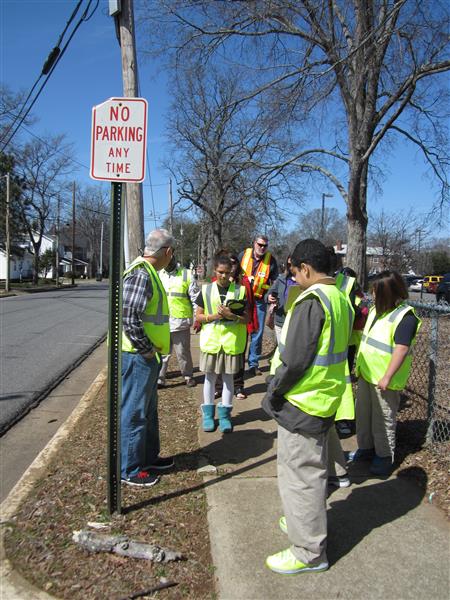Walking and bicycle audits are a systematic approach for identifying barriers or challenges to walking or bicycling within a select community or corridor. Cities and communities can use audits to locate the specific hazards and hardships to walking or biking for the student or general population. They can be done separately, or as part of an overall bicycle or pedestrian plan. . Audits include a tour of the route or location (e.g., school, corridor, neighborhood, etc.), during which participants identify issues related to walking and biking, followed by a debriefing and brainstorming session to prioritize the concerns and identify potential solutions.
Why is this important to your community?
Walking and bicycle audits uncover information that communities can use to analyze and improve the design, condition and functionality of the transportation infrastructure for pedestrians and bicyclists.
In the CONNECT Our Future report on Public Health Disparities Assessment and Identification for Action (link), active transportation is identified as one of five health-related issues that cuts across several of the region’s top priorities. Creating safe, comfortable and convenient environments for walking and bicycling makes these transportation modes more attractive and a more viable choice for residents and visitors. The benefits of this modal shift also can include reduced commuting costs, less congestion, better air quality, improved access to parks and other community destinations (libraries, schools, etc.), as well as a healthier population.
Audits establish baseline data and detailed recommendations that transportation planners and engineers can directly use to develop improvements to the active transportation network. An important aspect of conducting an audit is the active involvement of residents throughout the process, not only as data collectors and recommenders, but as users and advocates for walking and biking as realistic transportation options.
Where is it appropriate to use?
What priorities does it address?
What other tools are related?
- Safe Routes to School
How does it work?
An audit is best conducted on a specific area or site so that adequate time and resources are available to examine each element of the area in detail. Typically a focus area is a school, a segment of a corridor, or a portion of a neighborhood or town center, or other areas that the community identifies as potentially needing bicycle and pedestrian connections. Auditors (who may be concerned citizens, parents, school administrators, or neighborhood or downtown advocates) come together with transportation planners and engineers to, first, learn the elements of a safe street and to use that knowledge to identify barriers that create safety hazards or a gap in the pedestrian and bicycle network.
During an audit, which might take place over one or more days, participants systematically document information about the social, built, and natural environments that affect walking or bicycling. Conditions identified may include: narrow, broken, or lack of sidewalks; wide intersections with no pedestrian crossing; lack of pedestrian crossing signals; a built environment or land use pattern that contributes to unsafe or unwelcome walking conditions (i.e. vacancy, buildings far from the street, uses with limited activity hours); lack of or inadequate lighting; lack of or insufficient bicycle facilities; and topographic and other natural environment challenges.
Conditions are measured, photographed, and marked on map exhibits. Pedestrian, bicycle and sometimes transit counts are also recorded at various times of day at key intersections and destinations. The findings of the audit are discussed and compiled into a graphically-rich report to be used as a resource for community safety programs and capital improvements in the community or school district, or as part of a community-wide bicycle or pedestrian plan.
Resources
- NCDOT Division of Bicycle and Pedestrian Transportation (DBPT) – Annual Grant Program
- SCDOT Bike and Pedestrian Program (including grant opportunities)
- Institute of Transportation Engineers (ITE) Guide to Walking and Bicycling Audits
- Pedestrian and Bicycle Information Center
- Safe Routes to School Online Guide
Ready to get started?
Using the Tool
- Review any existing bicycle or pedestrian plans:
- How current are they? Are they so old, that a walking and biking audit could help jump-start a new planning process?
- Did they include community input?
- What has happened with the recommendations?
- Do they provide information useful in identifying target areas for more detailed walking and biking audits?
- If no previous bicycle or pedestrian planning has been done, or plan completed, consider undertaking a plan, including audits. Funding opportunities may be explored through the State’s Department of Transportation bicycle and pedestrian program.
- If you decide to do an audit as part of an overall planning process or update to an existing plan, contact your MPO or RPO and the COG for information about funding or technical assistance possibilities.
- Identify target area for walking and bicycle audit based on your findings, stakeholder input or known areas of concern.
- If the area includes a school, determine if the school already has a Safe Routes to School (SRTS) Program or Task Force, and if so, engage them in the process of the audit.
- Meet with interested school officials, stakeholders, residents, and students to determine the capacity and interest for engaging in a walking and bicycling audit in the proposed areas, or in other or additional areas they might propose.
- Establish the audit team, which should include community members, stakeholders, and at least one transportation planner or engineer. Organize a day or series of days to conduct the audit. Inform the team of the area’s demographics, and any facilities that may be of special interest or serve special populations. In one community, the town center was directly across from a college campus that had as part of its mission serving students with disabilities…important to know when conducting an audit!
- Instruct the team with the essential knowledge of how to review conditions. This should include a presentation covering issues such as: narrow, broken, or lack of sidewalks, wide intersections with no pedestrian crossing, lack of pedestrian crossing signals, a built environment or land use pattern that contributes to unsafe walking conditions (i.e. vacancy, buildings far from the street, uses with limited activity hours), lack of or insufficient lighting, lack of or insufficient bicycle facilities, or topographic and other natural environment challenges. Provide team with measurement tools, a camera, a map with street names, paper, and reflective safety vests. Remind the team to be on the lookout for any existing challenges bicyclists or pedestrians may face.
- Reconvene after the audit to debrief and share results and ideas. Identify individual(s) to be the point person to compile data and prepare the report.
- Finalize the report and share with neighborhood groups, the planning department, school administrators, and state agencies (i.e. DOT) to encourage capital investment to improve conditions for walking and bicycling.
- If done as part of an overall planning process, develop recommendations in formats needed to make the report useful for state DOT engineers and for CIP planning.
- Revisit the audit ever two to three years to determine if improvements have been achieved in the network.
Partners
- Advocacy Groups
- Colleges and Universities
- Community Development Organizations
- Health and Wellness Programs
- Landscape Architects, Planners, and Urban Designers
- MPOs, RPOs, and COGs
- Municipal Departments
Where has it worked?
Ebenezer Avenue Elementary School - Rock Hill, SC
 Image Source: South Carolina Department of Transportation.
Image Source: South Carolina Department of Transportation.
Contact
Chris Beard, Principal
cbeard@rhmail.orgAbout the Program
Ebenezer Avenue Elementary School initiated a Safe Routes to School (SRTS) program in 2012. The first program completed under the program was a walking and bicycling audit, which involved the upper classmen (sixth graders) working directly with the SRTS members, including representative of the state. Students were trained on how to spot challenges and deficiencies in the walking and biking network and helped identify barriers during the audit. The students became so interested in the topic of bicycle safety, that it evolved to be a part of the curriculum of the school’s physical education curriculum, and the school now keeps a fleet of bikes on-site to demonstrate appropriate pedestrian safety.
Why it works
The Safe Routes to School (SRTS) walking and bicycling audit was a success at Ebenezer Elementary because of the involvement of faculty and staff in encouraging student participation, and through the support of local organizations. Sixth grade students were directly involved in the creation of the curriculum of the bicycle safety program, and as the oldest students at the school, served as role models for the younger kids to be involved and excited as well. Eat Smart, Move More York County funded the curriculum development, while a professor at Winthrop University wrote and vetted the classroom content, with the intention that the curriculum could be used elsewhere in the state. The City of Rock Hill Parks and Recreation Department allowed the school to borrow bikes that the City owned for pilot classes, and Safe Kids York County provided helmets and fitted them for the sixth grade students. Eventually, the school was able to secure funding to purchase a fleet of bicycles to own long-term. In addition to generous partners, the program is also successful because it was careful to evaluate benchmarks and outcomes. During the initial pilots of the curriculum program, pre- and post-test scores showed that students were successfully learning bicycle safety skills. The school now offers its student-made bicycle safety curriculum to all sixth graders and hopes to expand the curriculum to addition grade levels in the future. The success of the program has been instrumental in inspiring support of events such as Bike to School Day and South Carolina Walk to School Day and encouraging other nearby schools to institute similar programs.
Haywood Road Pedestrian and Bicycle Safety Audit - Asheville, NC
 Image Source: Asheville Bicycle & Pedestrian Task Force.
Image Source: Asheville Bicycle & Pedestrian Task Force.
Contact
Barb Mee, Transportation Planner, Pedestrian and Bicycle Program Coordinator
828-232-4540
BMee@ashevillenc.govAbout the Program
Haywood Road was chosen by the Bicycle & Pedestrian Task Force to be the first pedestrian/bicycle safety audit conducted in Asheville due to its central location and connectivity between Downtown, the River Arts District, West Asheville shopping and residential areas, as well as schools and other pedestrian and bicycle trip generators. The corridor is located in West Asheville, a vibrant, mixed use neighborhood which in general lacks consistent bicycle and pedestrian facilities. The corridor has a mixture of pedestrian facilities with some gaps in the sidewalk system, but has recently seen major capital investments such as a roundabout, crosswalks and curb ramps, and the addition of new or upgraded sidewalks through new development. The audit provided an opportunity to review the impacts these investments were having on pedestrian and bicycling safety and activity in the area, and provide rationale for informing future design decisions and investments made by either the North Carolina Department of Transportation or Asheville’s Transportation and Planning Departments.
Why it works
The Haywood Road Pedestrian and Bicycle Safety Audit provided a great precedent for improving pedestrian safety, walking, bicycling and transit use along a busy corridor in West Asheville. The plan included detailed pedestrian and bicycling counts at key destinations and intersections along the corridor. Transit ridership was also recorded. By providing this type of data, the planners are able to compare future counts to this baseline data to see if measurable progress has been made as a result of capital improvements. In addition, the audit examined each intersection in detail, measuring crossing distance, crosswalk markings, bicycle signage, sidewalk width and condition, and ADA compliance. Recommendations will be carried forward to transportation planners to potentially include in the capital improvement plan. The evidence provided in the study makes the case for prioritizing such improvement to aid in pedestrian and bicycle safety, and transit use. The plan was made possible through the initiative of Asheville’s Bicycle & Pedestrian Task Force, which provided the energy and support to ensure that the study was completed.
- Colleges and Universities


